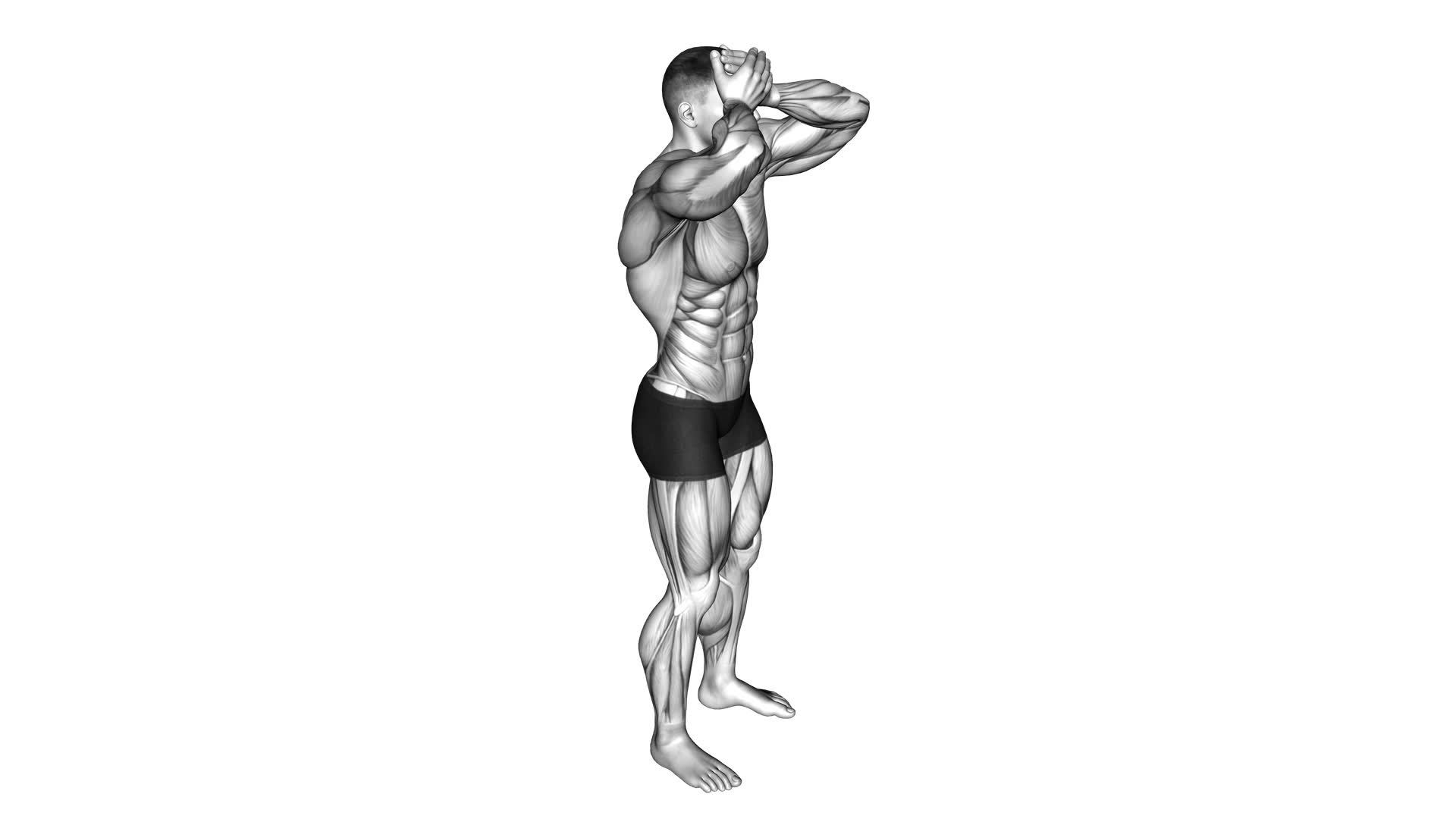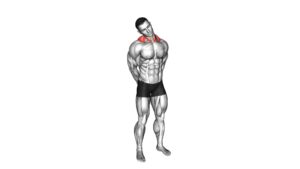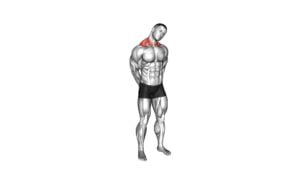Front and Back Neck Stretch – Video Exercise Guide & Tips

Are you looking for a quick and effective way to relieve tension in your neck? Look no further than the front and back neck stretch.
Watch This Exercise Video
This video exercise guide will show you the proper technique for stretching both the front and back of your neck. Learn how to avoid common mistakes and get the most out of this stretch.
With the help of safety precautions and modifications, you can safely incorporate this stretch into your routine.
Key Takeaways
- Front and back neck stretches can help relieve tension and tightness in the neck muscles.
- These stretches improve flexibility and range of motion in the neck.
- Proper technique, such as keeping the spine straight and shoulders relaxed, is important for maximizing the benefits of the stretch.
- It is important to consult with a healthcare professional for guidance on proper technique, modifications, and personalized recommendations.
Benefits of the Front and Back Neck Stretch
To improve flexibility and reduce tension, incorporate the front and back neck stretch into your routine. Regular neck stretching is important for posture improvement and overall well-being. There are different variations of neck stretches that you can try to target specific areas and achieve maximum benefits.
One variation is the front neck stretch, which targets the muscles in the front of your neck. This stretch helps to release tension and improve posture by lengthening the muscles that can become tight from activities such as sitting at a desk for long periods. To perform this stretch, sit or stand up straight and slowly tilt your head forward, bringing your chin towards your chest. Hold this position for about 30 seconds while feeling a gentle stretch in the front of your neck.
Transitioning to the subsequent section, it's important to learn the proper technique for the front neck stretch to ensure you're getting the most out of this exercise.
Proper Technique for the Front Neck Stretch
To properly perform the front neck stretch, follow these steps.
- Start by sitting or standing in a comfortable position with your spine straight and shoulders relaxed.
- Begin by tilting your head forward, keeping your chin parallel to the ground.
- Slowly bring your chin towards your chest, feeling a gentle stretch in the front of your neck.
- Make sure to keep your shoulders relaxed and avoid hunching or shrugging them.
- Hold this position for 15 to 30 seconds, breathing deeply and relaxing into the stretch.
- To deepen the stretch, you can use your hand to gently apply pressure on the back of your head, increasing the stretch in the front of your neck.
- However, be cautious not to apply too much pressure or pull on your neck, as this can lead to improper form and potential injury.
- This stretch is particularly beneficial for relieving muscle tightness in the front of the neck, which can be caused by poor posture, stress, or prolonged periods of sitting or working at a computer.
- Be sure to perform this stretch on both sides to maintain balance and symmetry in your neck muscles.
Proper Technique for the Back Neck Stretch
To properly perform the back neck stretch, start by sitting or standing in a comfortable position with your spine straight and shoulders relaxed. This stretch is beneficial for relieving tension in the back of your neck and preventing neck injuries. Here's how to do it correctly:
- Tuck your chin towards your chest: Gently lower your chin towards your chest until you feel a stretch in the back of your neck. Avoid forcing your chin down or straining your neck muscles.
- Hold the stretch: Maintain the position for 20-30 seconds, allowing your neck muscles to relax and stretch. Remember to breathe deeply and avoid any sudden movements.
- Release the stretch: Slowly lift your chin back to the starting position, keeping your neck relaxed throughout the movement.
- Repeat as needed: You can perform this stretch multiple times a day to help alleviate any tension or tightness in your back neck muscles.
Proper form is crucial when performing the back neck stretch to avoid injury. Avoid arching your back, shrugging your shoulders, or putting excessive pressure on your neck. By following these guidelines, you can safely incorporate the back neck stretch into your routine and experience its benefits in preventing neck injuries.
Common Mistakes to Avoid
When performing the front and back neck stretch, it's important to avoid some common mistakes that can compromise the effectiveness of the exercise and potentially lead to injury.
One common mistake is improper head position, such as tilting the head too far forward or backward.
Another mistake is neglecting the upper back during the stretch, which can limit the overall range of motion.
Lastly, overstretching the neck muscles by pulling too hard or holding the stretch for too long can also be detrimental.
Improper Head Position
Avoid tilting your head too far forward or backward when performing the front and back neck stretch exercise. Improper head position can lead to strain and discomfort in the neck and upper back. Here are some common mistakes to avoid:
- Overextension: Avoid excessively arching your neck backward, as this can strain the muscles and cause pain.
- Forward head posture: Don't jut your chin forward when stretching your neck forward. Maintain proper head alignment by keeping your chin level.
- Tension in the jaw: Avoid clenching your jaw or tensing your facial muscles during the exercise. Relax your jaw and focus on stretching the neck muscles.
- Rapid movements: Slow and controlled movements are essential to prevent injury. Avoid jerking or sudden movements that can strain the neck.
Neglecting Upper Back
Don't neglect your upper back during the front and back neck stretch exercise. Neglecting the upper back can lead to imbalances and potential upper back pain.
While the focus of this exercise is on stretching and strengthening the neck muscles, it's important to also pay attention to the upper back area. Neglecting the upper back can result in weakened muscles and poor posture, which can contribute to upper back pain.
To avoid this, make sure to engage your upper back muscles during the exercise by keeping your shoulders down and back. This will help to maintain proper alignment and distribute the load evenly throughout the neck and upper back.
Overstretching Neck Muscles
To ensure proper form and avoid potential injury, it's important to be mindful of the common mistake of overstretching the neck muscles during the front and back neck stretch exercise. Overstretching can lead to overuse injuries and exacerbate neck pain instead of providing relief. Here are four key points to keep in mind:
- Avoid forcefully pulling on your head: Pulling too hard can strain the muscles and put unnecessary stress on the neck joints.
- Maintain a gentle stretch: You should feel a mild tension in the muscles, but never push beyond your comfort zone.
- Focus on proper alignment: Keep your spine straight and avoid tilting your head too far forward or backward.
- Breathe and relax: Deep breathing during the stretch helps to release tension and promotes relaxation.
Tips for Getting the Most Out of the Stretch
To maximize the effectiveness of the front and back neck stretch, focus on maintaining proper alignment and engaging the core muscles. This will ensure that you're targeting the right muscles and preventing any unnecessary strain on your neck.
When performing the stretch, make sure to keep your spine straight and your shoulders relaxed. Avoid slouching or hunching over, as this can limit the stretch and potentially lead to discomfort.
Another tip for getting the most out of this stretch is to take your time and breathe deeply. Slowly move your head forward and backward, feeling the stretch in the front and back of your neck. As you do this, remember to inhale deeply through your nose and exhale through your mouth. This will help you relax and allow for a deeper stretch.
In terms of recommended frequency, it's generally recommended to perform this stretch two to three times a day. However, listen to your body and adjust the frequency based on your individual needs and comfort level. If you feel any pain or discomfort during the stretch, it's important to stop and consult with a healthcare professional.
Safety Precautions and Modifications
To ensure a safe and effective stretch, it's important to take certain safety precautions and consider modifications. Here are some tips to help you prevent injury and explore alternative exercises:
- Warm up: Before attempting any stretching exercises, make sure to warm up your muscles with light cardio exercises such as jogging or jumping jacks. This will increase blood flow to the muscles and prepare them for stretching.
- Start slowly: Begin with gentle stretches and gradually increase the intensity and duration over time. Avoid pushing yourself too hard and listen to your body's signals. If you feel pain or discomfort, stop immediately.
- Maintain proper form: It's crucial to maintain proper form throughout the stretch to avoid straining or injuring your neck. Keep your spine aligned and your shoulders relaxed. Don't force your neck into any uncomfortable positions.
- Modifications: If you have any pre-existing neck conditions or injuries, it's important to modify the stretch to suit your needs. Consult with a qualified professional such as a physical therapist or trainer who can guide you in finding alternative exercises that are safe and effective for you.
Frequently Asked Questions
How Long Should I Hold Each Stretch During the Front and Back Neck Stretch Exercise?
To maximize the benefits of neck stretching, it's important to hold each stretch for an appropriate duration.
You might be wondering, how long should you hold each stretch during the front and back neck stretch exercise? Well, the duration can vary depending on your fitness level and personal preference.
Generally, holding each stretch for about 20-30 seconds is a good starting point. This allows your muscles to relax and lengthen, promoting flexibility and relieving tension in the neck area.
Can the Front and Back Neck Stretch Help Alleviate Tension Headaches?
The front and back neck stretch exercise can indeed help alleviate tension headaches. By incorporating this stretch into your routine, you can experience the benefits of reducing muscle tension and promoting relaxation in your neck and upper back.
To perform this stretch safely, gently tilt your head forward and backward, feeling a gentle stretch in the front and back of your neck. Hold each stretch for about 10-30 seconds, making sure not to overstretch or strain your neck muscles.
Is It Safe to Perform the Front and Back Neck Stretch if I Have a Pre-Existing Neck Injury?
If you have a pre-existing neck injury, it's important to take precautions when performing the front and back neck stretch.
Consult with a healthcare professional or physical therapist to ensure that it's safe for you to engage in this exercise. They can provide specific guidelines and alternative stretches that will be more suitable for your condition.
It's crucial to prioritize your safety and avoid exacerbating any existing injuries.
Can the Front and Back Neck Stretch Help Improve Posture?
Improving posture and neck mobility can be achieved by incorporating the front and back neck stretch into your exercise routine. This stretch targets the muscles in your neck, helping to alleviate tension and improve flexibility.
Are There Any Variations or Modifications I Can Try to Make the Front and Back Neck Stretch More Challenging?
To make the front and back neck stretch more challenging, there are several variations and modifications you can try.
One option is to use a resistance band to add resistance to the stretch.
Another variation is to hold the stretch for a longer period of time, gradually increasing the duration as you become more comfortable.
You can also try incorporating a gentle head rotation during the stretch to target different muscles.
These modifications can help increase the intensity of the stretch and further improve your flexibility and posture.
Conclusion
Incorporating the front and back neck stretch into your exercise routine can bring numerous benefits, such as improved flexibility and reduced tension in the neck muscles. By following the proper technique and avoiding common mistakes, you can maximize the effectiveness of this stretch.
Remember to prioritize safety by listening to your body and modifying the stretch if needed. By implementing these tips, you can ensure that you're getting the most out of your front and back neck stretch.

Author
Years ago, the spark of my life’s passion ignited in my mind the moment I stepped into the local gym for the first time. The inaugural bead of perspiration, the initial endeavor, the very first surge of endorphins, and a sense of pride that washed over me post-workout marked the beginning of my deep-seated interest in strength sports, fitness, and sports nutrition. This very curiosity blossomed rapidly into a profound fascination, propelling me to earn a Master’s degree in Physical Education from the Academy of Physical Education in Krakow, followed by a Sports Manager diploma from the Jagiellonian University. My journey of growth led me to gain more specialized qualifications, such as being a certified personal trainer with a focus on sports dietetics, a lifeguard, and an instructor for wellness and corrective gymnastics. Theoretical knowledge paired seamlessly with practical experience, reinforcing my belief that the transformation of individuals under my guidance was also a reflection of my personal growth. This belief holds true even today. Each day, I strive to push the boundaries and explore new realms. These realms gently elevate me to greater heights. The unique combination of passion for my field and the continuous quest for growth fuels my drive to break new ground.







